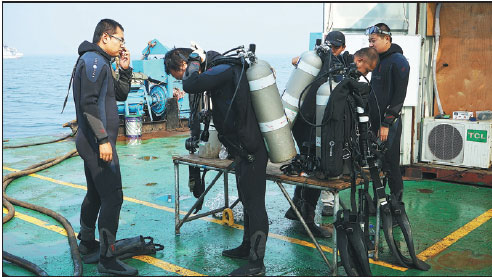Sunken Heroes
By Wang Kaihao (China Daily) Updated: 2017-01-03 07:54Archaeologists unveil the tragic story of a historic sea battle more than a century ago as they excavate an ironclad warship, Wang Kaihao reports.
An iconic Chinese warship and the 245 officers - soldiers and crewmen who have been keeping a silent underwater vigil for more than 120 years - have won their rightful place in history, thanks to three years of archaeological work.
The ironclad cruiser Zhiyuan (originally spelled "Chih Yuan") is a household name for Chinese people, a witness to a nation's courage, pain and past glory.
The wreck was first found in 2013, 50 kilometers from the port of Dandong, a city in Northeast China's Liaoning province, by port operators. Archaeological research began in early 2014. It was first referred to as Dandong No 1.
Last week, however, the National Center of Underwater Cultural Heritage held a symposium in Beijing to announce the field investigation has been completed, confirming that the wreck was indeed one of China's most fabled vessels.
More than 200 artifacts have been excavated from the shipwreck, including articles of daily use, construction materials and weapons. About 30 items were found in 2016, and they were definitive- including a ceramic plate inked with "Chih Yuan" and "Imperial Chinese Navy" in English.
Also found last year: a Gatling gun and a compact, handheld telescope, carved with the name "Chin Kin Kuai" (chief mate of the ship, Chen Jinkui), also in Romanized letters.
"The new findings in 2016 clearly show its identity, though it was suspected to be Zhiyuan before," says Zhou Chunshui, head of the archaeological team examining the wreck.
The discovery of distinctively quadrate (square or rectangular) portholes, for example, coincide with historical records of Zhiyuan.
"Our 20 team members made detailed forays into the cabin twice a day, and the discoveries went beyond our expectations," Zhou says.
The artifacts unveil a period in Chinese history that mixes triumph with grief.
Manufactured in Newcastle, England, between 1885 and 1887, Zhiyuan joined the Beiyang Fleet, which was painstakingly masterminded by the court of the Qing Dynasty(1644-1911) to be a sea power.
On Sept 17, 1894, the Battle of Yalu River - the largest naval engagement during the First Sino-Japanese War(1894-95) - broke out on the Yellow Sea near the estuary of the Yalu River.
Zhiyuan was sunk in the battle. Admiral Deng Shichang and all but seven of the 252 aboard died after the ship was hit by shells.
Deng commanded the ship to ram the nearby Japanese cruiser Yoshino while his ship was under siege, and is thus honored as a national hero.
"The status of Zhiyuan is incomparable," says Song Xinchao, deputy director of the State Administration of Cultural Heritage.
"And the First Sino-Japanese War, which is symbolized by the ship, changed the relationship between the two countries and the political environment in East Asia for the long term."
Song says the excavation not only promotes patriotism but also sets criteria for similar archaeological projects to follow.
"There are many sunken armor-plated ships from recent history along China's shores," he says, adding that experts lacked the experience and expertise for such excavations until now.
China's first scientific-research vessel specifically designed for underwater archaeology made its maiden voyage in 2014, and its first mission was the excavation of the wreck near Dandong. Advanced technologies like sonar and 3-D modeling were used for detection.
"The wreck was severely damaged due to corrosion," Zhou says. "Many parts were really rusty."
Historical files show the ship was 72 meters long, but only 61meters of it remain. Its original roughly 8-meter height has diminished to 2.5 meters.
Archaeologists have tried using zinc compounds to slow the corrosion.
Another challenge is that the whole wreck was buried in sand, which had to be cleared away slowly by excavators.
How - and if - the wreck can be exhibited in the future has yet to be determined.
According to Ding Hui, a cultural official in the Liaoning provincial government, the province will seek the status as a province-level cultural heritage for the site and mark a protection zone around the wreck. But he admits there are difficulties.
"The artifacts relevant to Zhiyuan were scattered in a larger area than the ship per se," he says.
The wreck also lies in a busy commercial shipping area, so balancing cultural-heritage protection and port construction is difficult. Some have proposed raising the ship out of the water to put it on public show, but experts are divided.
Cui Yong, a researcher who participated in the project, worries the 1,600-ton ship is too fragile to be salvaged.
Other options include virtual exhibitions that digitize the archaeological findings.
"If the shipwreck stays where it is, we can also have a museum or a memorial above the water," says Hang Kan, dean of the school of archaeology and museology at Peking University.
Hang cites the example of the USS Arizona Memorial in Hawaii.
Zhou, the archaeological team leader, recalls once having spent a few minutes in silence upon seeing soldiers' remains underwater.
The history of the ship is making officials proceed carefully before any plan is decided.
Contact the writer at wangkaihao@chinadaily.com.cn
|
Archaeologists prepare for the underwater field research of the Zhiyuan. |
- 'Cooperation is complementary'
- Worldwide manhunt nets 50th fugitive
- China-Japan meet seeks cooperation
- Agency ensuring natural gas supply
- Global manhunt sees China catch its 50th fugitive
- Call for 'Red Boat Spirit' a noble goal, official says
- China 'open to world' of foreign talent
- Free trade studies agreed on as Li meets with Canadian PM Trudeau
- Emojis on austerity rules from top anti-graft authority go viral
- Xi: All aboard internet express












